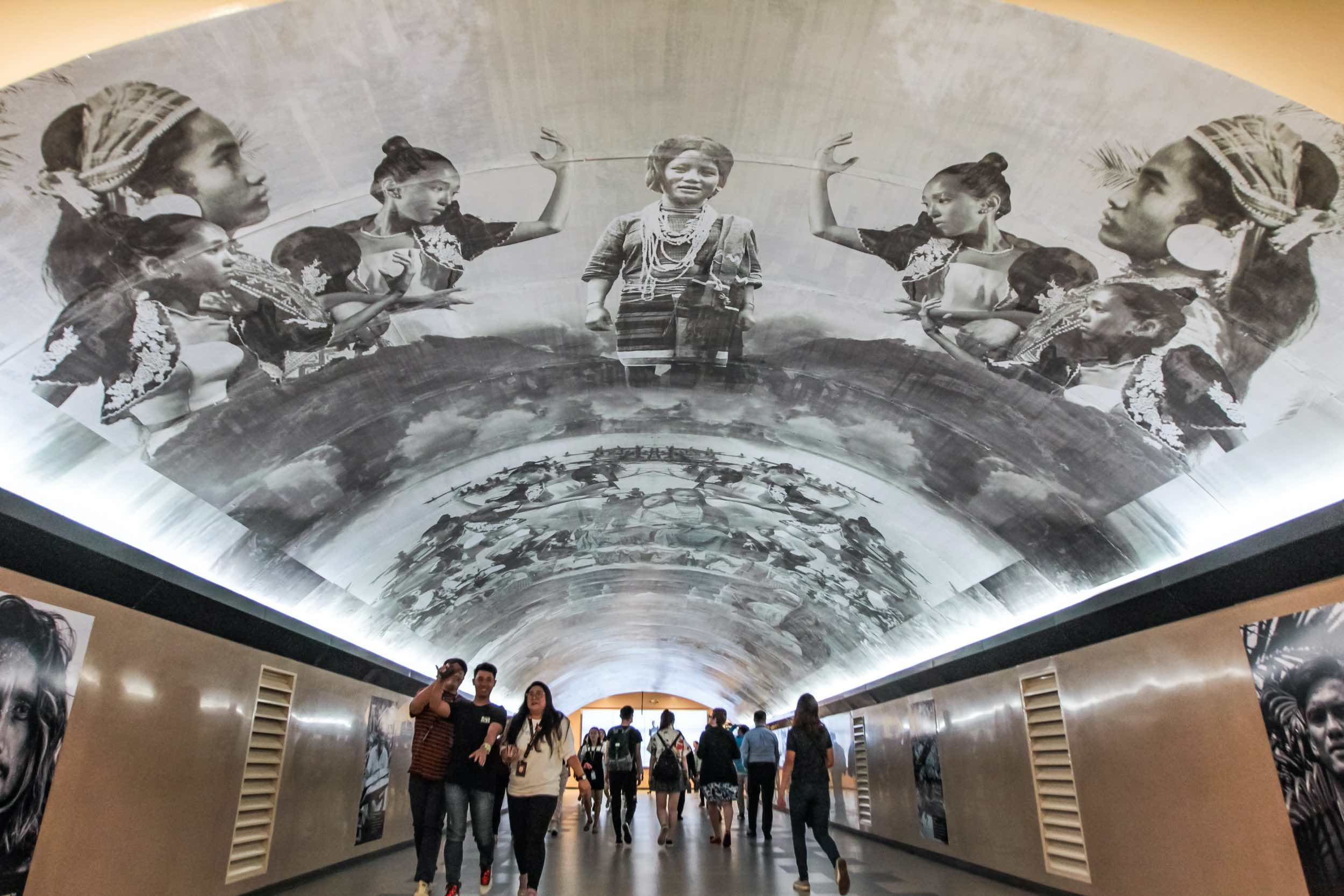Walked through the Salcedo Underpass in Makati City’s Salcedo Village lately?
Well, in case you missed it, in the last few weeks, the pedestrian tunnel has been given a massive artistic facelift in the form of an intricate black-and-white, 2,000-square-foot mural created by artist Archie Geotina.
“Ang Lakbay ng 105 Milyon” (“Journey of the 105 Million”), a nod to the Philippines’ population, stretches across the Salcedo Underpass’s entire ceiling. The Sistine Chapel-like (indulge us) public art installation is a composite of the country’s best spots, heritage sites, and “unsung heroes.” LED screens placed along the bustling Makati underpass’ walls also run videos on a loop, which the “self-taught” creative also directed and produced.
In an email interview, Coconuts Manila spoke with Geotina about the “everyday people, real heroes” who inspired the massive public artwork, how he learned to pay closer attention by living on an island in Siargao, and why public art matters.

How long did it take you to make the epic collage in Salcedo Underpass, and what was the process like?
Creating the whole mural took about three to four months of traveling, shooting, documenting images, and designing it all together at the same time. It took a long time just to get the right elements in the piece — they’re not just random images we sort out of context just to fit the story.
This process is the way I have always made my work: Starting with the architecture of the ceiling, then deciding how to play with it. After that, my team and I talk to engineers and architects to see the measurements and limitations for the idea to be executed before the piece is finalized then installed with a team.
What was the inspiration behind it?
To put it simply, it was inspired by the people I’ve met along the way in my life. People who, when I saw what they were doing, struck a chord, and resonated with me. People who inspired me in how I approach life, our culture, and our expression. It’s everyday people, real heroes, real people. I veered away from celebrities and have always been inspired by what these simple yet heroic people have left as a legacy to others in their community.
It’s the Sistine Chapel, plus our environment, plus our culture, plus real people.
At 2,000 square feet, is it the biggest mural you’ve made yet? Or have you done similar large-scale works in the past?
It’s one of the biggest and most complete conceptually, because apart from the huge mural, I also directed and produced a video accompanying this piece. The video plays on the LED screens in the underpass.
I wouldn’t be able to execute all of this work if it wasn’t for [commissioning real estate company] Federal Land giving me complete trust and creative freedom. I also wouldn’t also be able to execute this if it wasn’t for the quality of talent I surrounded myself with: the photographers who contributed their images, the sound engineers who created the soundtrack for the video, and a muse who danced and provided a symbolism for the piece. It takes one person to spark an idea, but it takes a village to create a movement.
But your art isn’t limited to murals only—we saw some of your skull sculptures. How long have you been making art, and what other mediums have you been pursuing?
Ah, the skulls are called “Everyday Above Ground Is Gold” I just finished an exhibition in Provenance Gallery in Shangri-la BGC [Bonifacio Global City] last Jan. 16. That show was to give light to the victims of the Marawi siege. It was for the benefit of the “Teach Peace Build Peace Movement,” an NGO which champions peace curriculums to war-torn areas of our country.
But the bigger vision was to shed more light unto the forgotten images of Marawi. I wanted to give the people there a voice because they inspired me. Some heroes of Marawi are the heroes highlighted in the Salcedo Underpass too.
I’ve been making art since 2007 professionally, so about 13 years. I mostly work with photography and paper. But I don’t shy away from using whatever medium I have to use to express the idea like the porcelain in my art piece “Everyday Above Ground is Gold.

Why do you think public art matters?
It’s there to make you question things. Why is that person there? What is this image for? Should I go ahead to work or should I take a picture with this piece? Is the paint still wet? Can I touch it? Can I piss on this wall? Things that you normally don’t ask yourself if you’re rushing away running in life’s hamster wheel.
Public art matters because, in my mind, it’s an exercise in communication regardless of race, gender, social stature, or political standpoint. Great public art gets people together to celebrate similarities, and even differences.
Where do you hail from, by the way? And in your opinion, which part of the Filipino experience do you think heavily influences Filipino art?
I grew up in Manila, spent most of my life in city culture but I have been living on an island called Siargao for the past three to four years now. That’s where I learned how to appreciate and listen more than speak. I learned it from the humility of the people I met there while also surfing.
I don’t really know what part of the Philippine experience influences Filipino art. I think Filipino art comes from every Filipino and their personal experiences and tastes create Filipino art. It’s not anything standard. It’s individual and subjective.
This interview has been lightly condensed and edited for clarity.
Read more arts coverage from Coconuts Manila here.





Reader Interactions